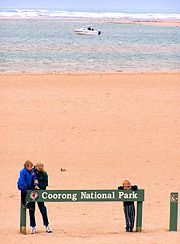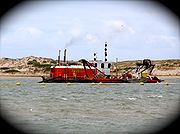- Murray Mouth
-
Murray Mouth (35°33′29″S 138°52′50″E / 35.55806°S 138.88056°ECoordinates: 35°33′29″S 138°52′50″E / 35.55806°S 138.88056°E) is the point at which the River Murray meets the southern Southern Ocean. The Murray Mouth's location is changeable. Historical records show that the channel out to sea moves along the sand dunes over time. At times of greater river flow and rough seas, the two bodies of water would erode the sand dunes to create a new channel leaving the old one to silt and disappear.
The mouth is between two sandhill peninsulas. Sir Richard Peninsula on the northwest separates the Goolwa channel (the main river channel) from the ocean. The much longer Younghusband Peninsula separates the Coorong from the ocean on the southeast of the mouth.
The Murray Mouth is separated from Lake Alexandrina by a row of low islands. The largest one, directly facing the mouth, is Hindmarsh Island. A series of barrages join the islands, separating the salt water from the fresh water of the lakes and river. The barrages can be opened during high river flow.
Ancient History
The original course of the Murray River was to a mouth near Port Pirie where a large delta is still visible protruding into the calm waters of Spencer Gulf. An uplift of the land blocked the river near the southern end of the Flinders Ranges, and the river eventually found its way to a new mouth near Lake Alexandrina.
Water flow
River Murray water is used by farmers for irrigation in four of Australia's states, as well as supplying water to most towns along the river, and many further away through various pipelines. It has been widely accepted that too much water is being extracted; however business and political concerns make it difficult to remedy the problem. A visible symptom of the over-extraction of river water is the closing of the Murray Mouth.
Since October 2002, two dredging machines have operated at the Murray Mouth, moving sand from the channel to maintain a minimal flow from the sea and into the Coorong's lagoon system. Without the 24-hour dredging, the mouth would silt up and close, cutting the supply of fresh seawater into the Coorong, which would then warm up, stagnate and die.
In mid-2006 the dredging was scaled back as a result of the improved conditions at the mouth. Now only one dredging machine operates, and permission was granted to one commercial operator to navigate the channel between Goolwa and the Coorong, passing the mouth.
External links
- South Coast Story, John C Tolley, Rowett Print, Mt Compass SA, 1968 ISBN 0-9587964-3-2
Categories:
Wikimedia Foundation. 2010.


